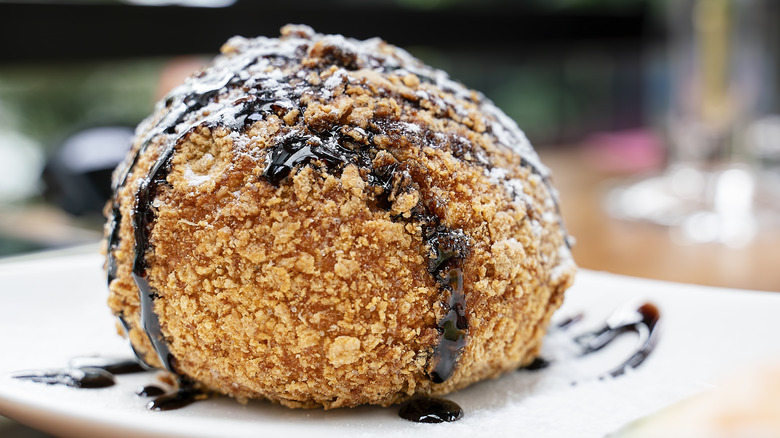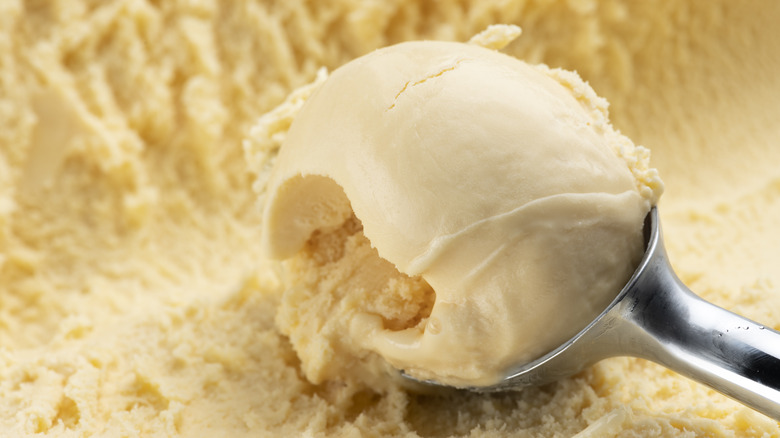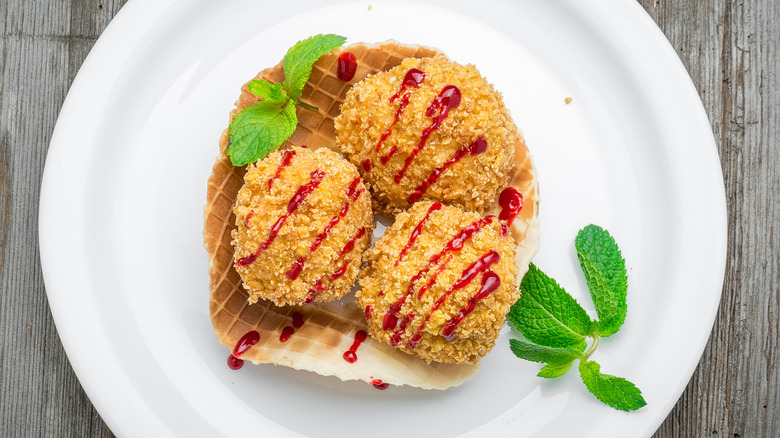The Science Behind Why Fried Ice Cream Doesn't Melt
There are few dessert concepts quite as hard to wrap your brain around as fried ice cream. After all, dunking a large ball of the frozen food into steaming hot oil seems like it would be an exercise in frustration. Yet instead, when expertly executed, the result is a perfectly cold and creamy treat encased in crispy goodness.
Details on where the dessert was first made are murky, but the now-shuttered Mexican chain restaurant Chi-Chi's has been credited with helping propel the dessert to stardom in the United States several decades ago. It can still be found on restaurant menus — often at Mexican restaurants — and it's a sure way to evoke a quizzical look out of anyone who's unfamiliar with it. So, what kind of wizardry is required to create the frozen yet fried concoction?
Though the process does seem like it would take a little magic, it turns out some simple science is at work. Coating the frozen ball of ice cream with just the right ingredients creates a layer of insulation that protects the ice cream from melting.
How to make fried ice cream without it melting
To make fried ice cream, you must first scoop out the balls and place them back in the freezer to harden. By keeping the ice cream as chilled as possible, you reduce the chance of it melting while frying.
Once the ice cream balls are frozen solid, create the first layer of insulation on the outside by rolling them in egg whites or cake batter. For the second layer, roll them in a crunchy ingredient that's either sweet or savory — crushed cookies, cereal, potato chips, or panko all work well.
Now, NASA likens comets to fried ice cream, but making this treat isn't really rocket science. A less complicated analogy might be between fried ice cream's outer layers and your standard cooler on a hot day. By encasing the super-cold ice cream with the outer layers of ingredients, you're protecting the ice cream from the heat, just like those ice-cold beverages in the cooler.
Tips and tricks for the best fried ice cream
Just like you know there's a time limit on how long your craft brews will stay cold in the cooler, you'll need to be mindful of your timing when frying the ice cream. Each ice cream ball needs less than a minute to fry in the hot oil. Once they're golden brown, they're ready to be removed.
Another way to avoid winding up with a melted ice cream mess is to wear gloves when handling the ice cream balls with your hands. Minimizing the amount of heat transferred from your hands to the ice cream will help it to remain cold longer.
As with any frying recipe, it's important to also be precise about the oil's temperature (375 degrees Fahrenheit is ideal). If it's not hot enough, the outer layers will become soggy, and if it's too hot the outer layers will not cook correctly. Also, heating oil beyond the recommended temperature could result in the oil rising above the top of the pot when the frozen balls are dropped in, creating not only a mess but a fire hazard, too.
Some other tricks for making the perfect fried ice cream include helping the balls retain their shape by placing them in muffin tins, adding spices, and creating a third layer of insulation with a different crisp ingredient or the same. Or hack fried ice cream by just rolling frozen ice cream balls into a crispy topping and freezing them until ready to serve.



